!!!FREE PALESTINE ALL EYES ON RAFAH!!!♥️𝓭𝓪𝓻𝓵𝓲𝓷𝓰 ♥️ 17-19Other aliases: GinghamGrl, kai-arts, and Cecilquestioning plural / new system &chronic illness girlieAutizzyAbro/Trans/AroAceinteract PLSSSS: autistics, POC, disabled folks, systems, nice/funny ppl, xenos, crypids, and other weirdos inbetween!DNI-zionist, racist, sexist, homo/transphobe, mental illness demonizers, transID, MAP/NOMAPS, zoos, pro-SH,
Don't wanna be here? Send us removal request.
Note
Save Mohammed ….
Hello, Please Help Me – My Son May Die at Any Moment. Donate or at Least Share This Appeal. I am in desperate need of your help. My son’s life is hanging by a thread, and he may not survive without urgent medical treatment. Time is running out, and we are facing a critical situation. I am asking for your generosity to help us save him – either through a donation or by sharing this urgent plea with others.
I beg you, kiss your feet, to help my son. My son may die at any moment
Donate now:👇👇 gofundme.com
gaza #free_palestine #Save_Mohammed #genocide
Please go help this family escape gaza!
Unfortunately i can't donate anything but hopefully someone will. I prau for your son
1 note
·
View note
Text
genuinely what does it take for y’all to give a shit. Mohammed Ayesh works daily in the line of fire transporting injured Palestinians from their bombed tents to the nearest hospitals for treatment. Then he walks for miles sometimes to talk to and verify Palestinian families’ campaigns when he’s off work. This has been his reality for the past few months.
We’ve only raised a bit over £100 today. This is shameful. There was literally a tank that stopped right next to where Mohammed and his family were hiding this morning (including his kid brother, whose eardrums burst a decade ago when he was an infant under constant iof bombardment).
I’m asking you all to give a shit. If you have money to buy a morning cup of americano you can donate at least £5 to Mohammed so he can relocate his family and keep doing his work on and offline.
3K notes
·
View notes
Text
i've been feeling incredible anger and frustration lately with these posts lamenting what the next four years will look like in the u.s., how much "worse" things will get under the trump administration, as if we haven't been witnessing a holocaust for the past year funded by the biden administration. if you have seen a single video from gaza, a single picture, read a feature from a gazan journalist, spoken to a single person in your inbox when they plead for your attention and help, words like "worse" or "better" turn to ash in your mouth. just yesterday my friend hilda texted me that even when her family manages to get food, smoke from the fire needed to cook aggravates her sinus allergies, making it difficult to breathe. this is how she's been living for the past year and a month, under a democrat-funded genocide.
below is a small fraction of the palestinians who have reached out to me for help with their campaigns. it is a huge source of shame to me that i can't keep up with all of the people in my inbox. please go to their accounts and read their stories. and please give what you can spare.
hilda @hildanasr1 / GFM - 5%
dina @dina179 / GFM - 33%
yousseff @youseffamily / GFM - 92%
suad @suad-khaled / GFM - 51%
nada @nadamd44 / GFM - 1%
asma @asmaayyad2 / GFM - 62%
shehab family @reemshehabnew / GFM - 90%
yahya @yahyabkheet-blog / GFM - 21%
mohammed @mohammed-hassouna1 / GFM - 19%
abdulrahman @3bdulra7manosama / GFM - 9%
mai @abuhamdasblog / GFM - 5%
ibrahim @aburakhiaibrahim / GFM - 22%
mona @mansh99 / GFM - 13%
ahmed @najah-meshal5 / GFM - 16%
noor @noor-yashour / GFM - 10%
*ALL CAMPAIGNS ARE VETTED*
10K notes
·
View notes
Text
i think if my partner kills themselves im gonna kill myself
#jiraiblogging#my first jirai post#i can’t live without him#mental illness#jirai kei#im gonna explode
0 notes
Text
Spoonie Life Tip #4
Ice might not help, but it will rarely hurt. Heat feels good, but can make some things worse. So if you’re not sure, pick ice.
20 notes
·
View notes
Text
My symptoms were flaring so bad today I hope tmrw is better. I didn't even have an actual episode or anything just pain, fatigue and fighting to stay conscious and you'd be surprised how hard it was to do that. I hope I can get my mobility aids soon. I can not live a life of being confined to a bed or my house and being held back from doing things simply bc I can't walk those days. If anyone has advice for how to make these kinds of days better by all means give it here! Pls!! I wanna make my life as a disabled person a little bit better.
#actually disabled#bunni posts#disabled#ginghamgrl posts :d#functional neurological disorder#invisible disability#future wheelchair user#future crutches user#future rollator user#mobility aid#guys the disability is actually disabling me guys‼️‼️‼️‼️#help Dx#wheelchair#chronic illness#chronic fatigue#im mclosing it‼️‼️‼️‼️
7 notes
·
View notes
Text
Tbh I need the functional tics=tourrettes ppl to explain this but add credible sources. Like it's not that I don't believe you but it does sound kinda like a strange and empty theory rather than what I'm assuming is apparently supposed to be a fact.
Like I'm trying not to say that your lying, but if ur gonna make those kinds of claims or any claims about medical conditions (esp conditions that ppl don't know Abt or is rare) SHOW ME YOUR SOURCES OR IM GONNA ASSUME UR JUST YAPPING ABT SOMETHING U DONT UNDERSTAND. (Or just lying)
#actually disabled#bunni posts#disabled#ginghamgrl posts :d#functional neurological disorder#invisible disability#functional tics#tic disorders#tics#site ur sources ppl#comming from someone with functional tics and FND#:/ yeah
4 notes
·
View notes
Text
Celebrating Samhain
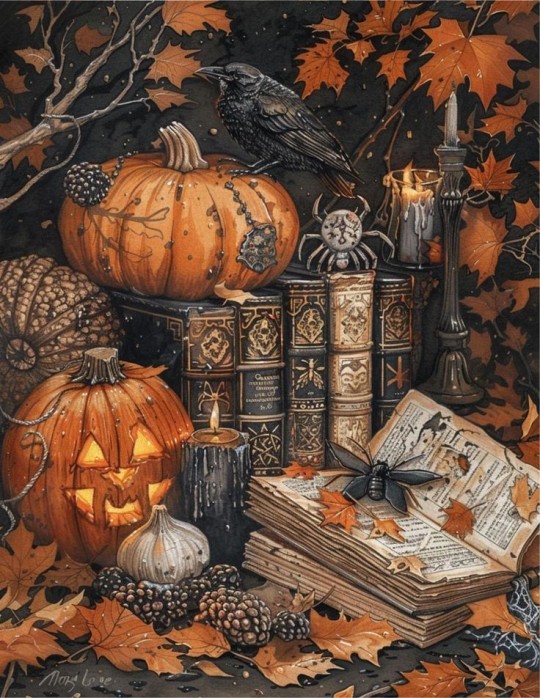
Samhain, pronounced "SAH-win", is the eighth Sabbat and final spoke on the Wheel of the Year. With ancient Celtic origins, Samhain was one of the four fire festivals, and falls at the halfway point between the Autumn Equinox ans Winter Solstice. Opposing Beltane on the Wheel, Samhain also similarly features a 'thinning of the Veil', a time when the barrier between our world and that of spirits and other magickal entities is weakened and easier to cross. While Beltane famously is a strong time to interact with the Fae due to the Veil thinning, Samhain is most known for interactions with spiritual entities, the dead, and ancestors.
Samhain is also known as the third and final Harvest Festival (the first being Lughnasadh, and the second Mabon). The frost is coming, and most of the produce has been collected from the fields and stored away. As people prepared for oncoming harsh weather and lack of food/resources, they had to cut back on everything that wasn't crucial to their survival. Thus, this festival was the time of the animal harvest. All creatures who could not be fed through the harsh Winter were harvested during this time, and celebrated for their sacrifice.
Other names for Samhain and similar celebrations include:
• Halloween
• All Hallow's Eve
• The Witch's New Year
• The Third/Final Harvest
• Calan Gaeaf, "The First Day Of Winter"
• Oiche Shamnhna
• All Soul's Day
• All Saint's Day
• Devil's Night
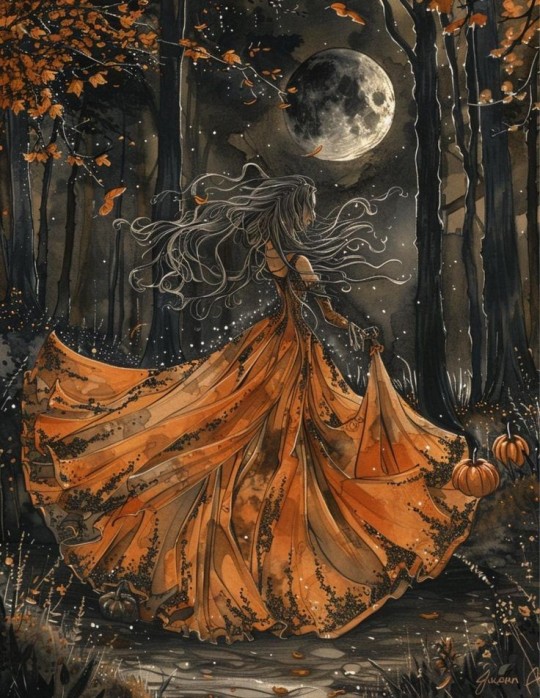
Common Samhain Traditions
• The Dumb Supper is when a meal is hosted and consumed by the living, but the dead and spirits are invited to participate and given seats and places at the table as a sign of respect. Often the windows are all open during a Dumb Supper to invite the spirits into a home. Sometimes specific spirits or ancestors are invited or the invitation is simply left open to any spirits that wish to attend. The living attendants traditionally eat in silence to honor the spirits and hear their messages.
• Carving Jack-O-Lanterns originally came from the myth of "Stringy Jack", which is an Irish folktale about a man who tricked the Devil and now has to wander the world with a lit piece of coal protected inside a carved turnip. This evolved into people carving their own turnips and potatoes and placing them in windows or doorways to scare away Stringy Jack and other tricky or potentially harmful spirits. Once Irish immigrants came to America, the tradition was continued with pumpkins.
• Trick-Or-Treating is also derived from old Samhain traditions. The Celts believed that by dressing up they were disguising themselves from negative spirits who wandered the Earth on Samhain. In the Middle-Ages, "guising" was when children or impoverished people would dress in costumes and go door-to-door begging for food in exchange for songs or prayers. This practice was known as "souling" and the participants called "soulers". In Ireland, the practice of "mumming" involved dressing up in costumes and going door-to-door to sing in exchange for tasty cakes and baked goods.
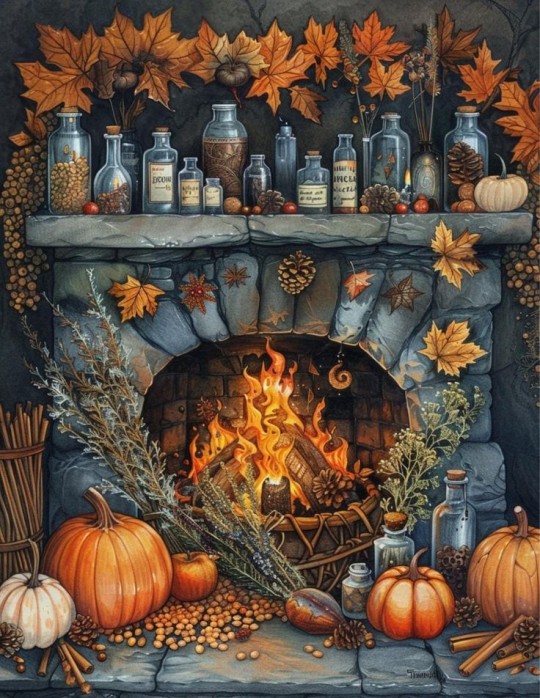
Samhain Correspondences
Colors:
• Black
• Green
• Orange
• Purple
• Red
• Silver
Crystals:
• Black Obsidian
• Bloodstone
• Amethyst
• Black Tourmaline
• Carnelian
• Jasper
• Jet
• Malachite
• Iolite
• Onyx
• Vivianite
• Ruby
• Smokey Quartz
• Garnet
Herbs/Plants:
• Cedar
• Allspice
• Cinnamon
• Hemlock
• Sage
• Rosemary
• Patchouli
• Hazel
• Dittany of Crete
• Bay
• Clove
• Belladonna
• Dragon's Blood
• Wormwood
• Mandrake
• Mugwort
• Snapdragon
• Gourds
• Nutmeg
• Frankincense
• Ginger
• Pine
• Hyssop
• Marigold
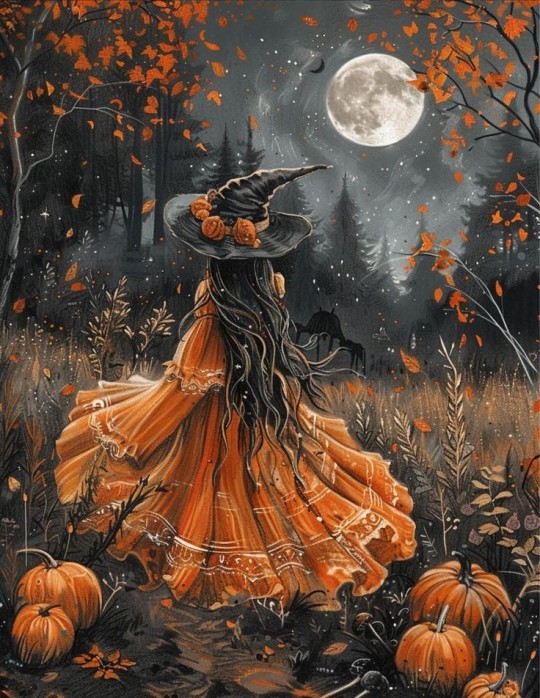
Animals:
• Bats
• Snakes
• Cats
• Spiders
• Scorpions
• Coyotes
• Jackals
• Dogs
• Wolves
• Foxes
• Crows
• Ravens
• Owls
• Rats
• Stags
Food/Drink:
• Pumpkins
• Cider
• Beef
• Chicken
• Pork
• Cranberries
• Turnips
• Potatoes
• Garlic
• Soups/stews
• Pears
• Corn
• Ale
• Apples
• Grain
• Pies
Deities:
• Hekate
• Lucifer
• Anubis
• Loki
• Lilith
• Morrigan
• Nyx
• Hades
• Persephone
• Osiris
• Apollo
• Cerridwen
• Hel
• Freya
• Demeter
• Bast
• Mercury
• Yama
• Dis
• Herne
Magickal Workings:
• Spirit Work
• Ancestral Work
• Banishing
• Cleansing
• Divination
• Baneful Magick
• Shadow Work
• Rebirth/Resurrection
• Transformation
• Creativity
• Defensive Magick
• Preparation
• Ambition
• Purification
• Protection
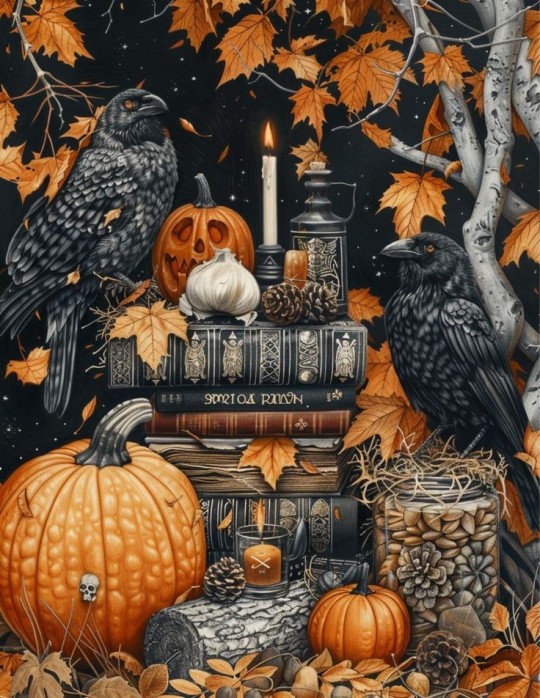
Bonus: Samhain Incense Recipe
• 2 parts Rosemary
• 1 part Frankincense
• 1 part Cinnamon
• 1 part Cloves
• 1 part Patchouli
• 1/2 part Sage
• 1/4 part Hyssop
• Pinch of Sea Salt
144 notes
·
View notes
Text

I found the this wheel of the year wreath image online but despite searching couldn’t figure out who created it! If anyone does know please comment below! I thought it was such a nice idea, maybe one day I’ll try to make some myself.
741 notes
·
View notes
Text

All About Lughnasadh
Lughnasadh, also known as Lughnasa or Lúnasa, is the name given to the Gaelic festival that represents the beginning of the harvest season, which traditionally falls on August 1st in the northern hemisphere. The holiday is about halfway between the summer solstice and autumn equinox, and is one of the 4 Gaelic seasonal festivals. Although it is traditionally Irish, many neopagans celebrate the holiday as well.
Traditionally named after the Irish God Lugh, Lughnasadh has been documented to be celebrated since at least the middle ages and involved great gatherings, ceremonies, athletic games like the Tailteann Games, feasting, horse racing, matchmaking, trading, and more, and were traditionally celebrated on top of hills and mountains. The festival remained widely celebrated until about the 20th century, where it seemed to be replaced by Christian counterparts.
Lugh, the God the festival is named after, is said to have founded the holiday as a funeral feast and funeral games to commemorate the death of an earth goddess. The Irish stories vary throughout regions and times, but it usually involves a woman who is stolen away or held against her will and dies of grief, shame, exhaustion, or unspecified causes. There is notable similarities to the Greek Persephone tale. According to a tale about the Lughnasadh festival site Tailtin, it is said to be a funeral for his foster-mother, Tailtiu, who was said to have died from exhaustion after clearing the plains of Ireland for agriculture. A tale about the Lughnasadh site Naas, says the festival was founded in the memory of his two wives, Nás and Bói. Another theory states it was a mourning for the end of summer.
Máire MacNeill, a folklorist, studied the later lore of the holiday and claims it is about a struggle for the harvest between Lugh and another god, often named Crom Dubh. In some stories Lugh must seize Crom Dubh's treasure of grain to give to all of mankind. In other stories, it's over a woman named Eithne who represents grain. Othertimes, its a battle of Lugh defeating a figure representing blight. There doesn't seem to be one agreed upon legend, other than it's revolving around the God Lugh.
As for ancient customs and traditions, they can vary region to region and have morphed throughout time. However, a big tradition was the gathering at Óenach Tailten, a type of olympic style games and gathering where kings declared truces during the entire festival in order to partake and compete against eachother. It included ritual athletic and sporting competitions, horse racing, music and storytelling, trading, law-making and settling legal disputes, creating contracts, and even matchmaking. A common matchmaking tradition was allowing couples to enter a trial marriage that lasted a year and a day by joining hands through a wooden door, after of which they could make permanent or break without consequences once the trial marriage was up. One gathering, called the Óenach Carmain, also consisted of a food and livestock market along with a market for foreign traders.
Other traditions also included a solemn cutting of the first corn to be offered to the deity by bringing it to a high place and burying it, a meal for everyone consisting of the new food and blueberries, a sacrifice and rituals involving a sacred bull, a ritual dance-play, reenactment of the lore, and closing ceremonies. Climbing hills and mountains were also a popular tradition, but has been rebranded overtime as Christian pilgrimages. At some gatherings, everyone wore flowers and climbed a hill, where they buried said flowers at the top to signify the ending of summer. At other gatherings, the first sheaf of harvest was buried instead.
A popular tradition up until about the 18th century were faction fights where young men fought eachother with sticks. One such game consisted of building towers of sod topped with a flag to defend from the other team's sabotaging. Bull sacrifices were also recorded into the 18th century, being used as offerings to various deities, along with special meals made from the first harvest. A special cake called the lunastain was also recorded. Visiting holy wells was also a very prominent tradition, just like during the other yearly festivals. Although bonfires were associated with Lughnasadh and the other main Celtic festivals, they were considered rare for this holiday, most likely due to the very warm summer temperatures.
Some traditions are still celebrated today in Ireland, with festivals being held in honor of Lughnasadh and re-enactors and historians reviving and teaching new generations old lore. There are still markets, traditional dancing, traditional storytelling, arts and craft workshops, feasting, and much more during these modern gatherings, keeping the traditions alive and well, even if they differ region to region. Some pagans and Wiccans also celebrate Lughnasadh, usually differing in their practices, but still using it as a signifier of the first harvest and summer's ending.
Lughnasadh Associations
Colors - yellow, orange, red, brown, green, gold, bronze
Food - blueberries, blackberries, grains, fruit, vegetables, bread, corn, beef, stews, lamb, wine, beer, cider, fruit drinks
Animals - bulls/cows, roosters, sheep
Items - scythes and harvest tools, grain/corn stalks
Crystals - citrine, aventurine, tigers eye, carnelian, topaz
Other - sporting/athletic competitive games, storytelling, matchmaking, cycle of life, harvest
Ways to celebrate:
gather blueberries or blackberries
enjoy grains or breads
make homemade bread
have a feast
climb a hill/take a pilgrimage
offer food to your deity(ies)
commit or recommit to your partner
harvest fresh food from your garden
visit a farmers market
complete a craft or make art
participate in an athletic competition or game
57 notes
·
View notes
Text
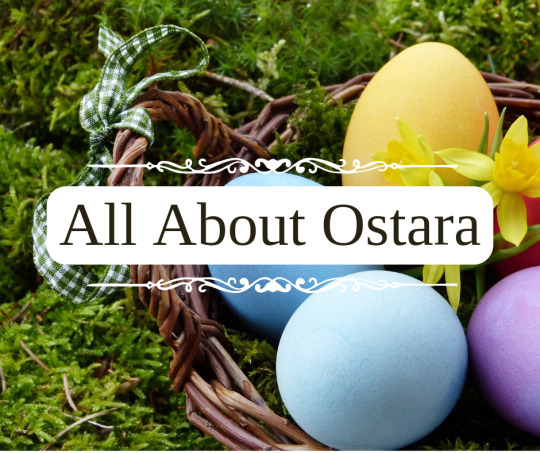
All About Ostara
In this context, Ostara is simply the name for the modern pagan celebration of the spring equinox, celebrated in the Northern Hemisphere around March 19th, or by some on the first full moon after the spring equinox. It is considered a Germanic holiday, but we'll talk a little about the different Goddesses associated with the holiday Ostara, as well as the history and where we're at today with our findings.
Unfortunately, there is not much historical text about the holiday Ostara or the associated ancient holiday Eostre, with the earliest known text being from an English monk from the 7th century, Venerable Bede. In his texts, he states that the rough equivalent of the month of April was dedicated to the Goddess Eostre and called Eosturmonath, but that was about all it mentioned.
Monks like Bede back in the day had orders to Christianize pagan traditions in order to slowly convert pagans to Christianity in the least-resistant way, which often meant adopting their festival dates, names of feasts, and whatnot, which was the purpose of mentioning this holiday in his texts in the first place.
Back in the day, the written reoccurant date of Easter had been debated since it began, as the Ressurection date was hard to nail down. Everyone just knew it happened in spring, so different regions celebrated it at different times. But, scholars believe the Christian church most likely saw that there were date overlaps in pagan celebrations, the Ressurection, and Passover as well, and decided to announce Easter Sunday would always fall on the sunday after the first full moon of the spring equinox, following popular pagan lunar traditions. They also adopted the new name from Eostre, cleverly combining the current pagan celebrations around rebirth and the sun into their own holiday traditions, in order to convert people to their religion, while also uniting their own people to celebrate on one date.
Although at one point these were all different celebrations, the Christian church did a very good job of combining and converting the pagan celebrations into their own, enmeshing them for life in history books and making it hard for modern day scholars to distinguish the origins of the pagan holidays seperate from the Christian church's.
After that, the next set of text with a reference to the holiday Ostara or Eostre came over a thousand years later during the Romantic period in 1835, by one of the Grimm brothers, Jacob, while he talked about mythology. In his work, he bridged Eostre with it's Germanic counterpart, Ostera or "Easter" as we know it today, and with the Goddess Ostara. In medieval Germany, they celebrated Ostarun in the month of Ostarmanoth, which gave way to the modern feast of Ostern ("Easter") today. He used these overlaps and more to claim that the two holidays and even Goddesses were most likely one historically
Just like with Grimm, there is mostly just speculation based on language, names, celebrations, etc. In modern-day society, it seems the holidays and Goddesses/Gods of Ostara, Eostre, and Easter have all been mashed up together from bridging multiple pagan religions with Christianity and struggling to seperate it again when we have almost no historical texts to help, since everything way back in the day was based on oral tradition.
As for the Goddess Eostre, who was supposedly a Goddess of fertility and light, she was so rooted in the region surrounding her that it was easier to adopt her namesake for the new Easter holiday (that enmeshed the series of Christian holidays) rather than rebrand under something Christian. According to Bede, her feasting was held in the month of April and celebrated spring. But that's all he mentioned, so her actual traditions have been lost to time, with only speculation to go off of.
After that, Grimm tried to link her with the Goddess Ostara, but we have no historical texts saying she is the same. Nowadays, the only mentions of the Goddess Eostre is with new-age pagan Wiccan practices where they, too, seemed to have linked her with the Goddess Ostara. Historically, it is most likely that the Goddess Eostre is a region-specific Goddess, as she was worshipped in Southeastern England by Anglo-Saxons, and that's where we see the oldest versions of her name referenced in text.
As for the Goddess Ostara, according to Grimm, she seems to have been the more wide-spread form of the Germanic Goddess Eostre, instead of region-specific, and he was the one who first translated her name to Ostara. This is the first historical text we have mentioning Ostara as a Goddess and not just a holiday, which means they (Eostre and Ostara) are technically one in the same, since Grimm was the one who translated the Goddesses name to German in the context that we use today.
In terms of associations with the newly translated Goddess Ostara, the first known reference of rabbits with Ostara in writing was mentioned in a mythology text written by Adolf Holtzmann in 1874 where he related the German tradition of the Easter Hare with Ostara by claiming the symbolism of 'the hare' was also probably sacred to the Goddess.
Afterwards, In 1889, an issue in the Journal of American Notes and Queries talks about the Germanic Tradition of the Easter Hare (gifting cotton stuffed flannel bunnies to children along with Easter eggs) and the story behind it, stating that "The hare was originally a bird, and was changed into a quadruped by the Goddess Ostara; in gratitude to Ostara or Eastre, the hare exercises its original bird function to lay eggs for the Goddess on her festal day." But that is as far as we've gotten in tracing it in texts.
Most likely, oral tradition has reigned supreme throughout history, and different narratives have surfaced about the origins of the symbolism with Ostara and rabbits and eggs and other things, so it's hard to know for certain what is "true" to celebrating the Goddess and holiday Ostara and what isn't.
In summary, based on the limited evidence that we have surrounding history on this holiday and deity(ies), you should feel free to celebrate Ostara in a way that is meaningful to you, especially since there is much overlap with multiple religions and practices. I did my best to round up the most commonly accepted ways to celebrate, the symbolism, and more related to the holiday and Goddess Ostara/Eostre.
Ostara Associations:
Colors - white, green, yellow, pink, purple, pastels
Food - eggs, fresh greens, dairy products, hot crossed buns, lamb, asparagus, honey, berries
Animals - hares/rabbits and song birds, baby animals, snakes
Items - decorated eggs, lillies, daffodils, tulips, crocuses, dandelions, lavender, other flowers, lemongrass, thyme, red clover, birch trees, seeds
Crystals - aquamarine, amethyst, rose quartz, moonstone, fluorite, amazonite, clear quartz
Other - fertility, renewal, dawn, spring, balance, joy, growth
Ways to Celebrate Ostara:
hold a feast, especially on the full moon after the equinox
plant seeds
connect with nature or go on a walk
decorate eggs
prepare your altar for spring
make a cotton stuffed flannel rabbit
decorate for spring with greenery and flowers
cleanse and clean your home
welcome the dawn and sunrise
bake hot crossed buns
create something
38 notes
·
View notes
Text

All About Mabon
Mabon is the name given to the pagan and Wiccan holiday that is celebrated on the autumn equinox. This year, it falls on September 22nd in the northern hemisphere. Although celebrations have been happening on the autumn equinox for centuries, Mabon as we know it today is a holiday coined and created around the 70s by new-age paganism and Wicca, named after the Welsh God. Although it doesn't have ancient roots, it does take inspiration from other autumn harvest festivals and participants have created beautiful ways to celebrate the neo-pagan holiday.
Just like other autumn equinox festivals, the main theme of Mabon seems to be one of transitioning seasons and giving thanks to the harvest and honoring nature. Many people consider it the pagan version of "Thanksgiving" as both holidays share many of the same symbolism and draw from seasonal items. Cornucopias play a big part in the symbolism of Mabon, representing a bountiful harvest, along with apples as well. Many people gather, feast, and spend time preparing for the long winter ahead as the days now grow shorter. Balance and scales also play a big role in celebrations due to the equinox, making it a great time to reflect on the give and take of life.
There doesn't seem to be one set way to celebrate Mabon due to its recent nature, so participants are encouraged to simply lean on the underlying themes of the holiday and celebrate in the ways that speak to them as they enjoy the universal shift in seasons.
Mabon Associations:
Colors - red, orange, brown, yellow, gold
Food - apples, squash, bread, corn, grains, root vegetables, grapes, nuts, pomegranates, wine, beer, cider, cinnamon
Animals - farm animals
Items - cornucopias, corn stalks, harvest tools, scales, acorns, autumn leaves
Crystals - amber, citrine, jasper, obsidian
Other - balance, change, thankfulness, reflection, letting go
Ways to celebrate:
have a feast
gather with loved ones and give thanks
write a list of everything you're grateful for
have a bonfire
decorate your home with Mabon and Autumn symbolism
harvest food from your garden
visit a farmers market
bake bread or pie
cook autumn themed food
write down goals for the coming season
create a Mabon altar
donate your time or money to those in need
go apple picking
cleanse and ward your home
stock up on food for winter
33 notes
·
View notes
Text

All About Imbolc
Imbolc, also known as Imbolg, celebrated on February 1st, marks the halfway point between the winter solstice and the spring equinox in early Ireland and Scotland, and also signified the beginning of the first signs of spring after all the harsh winter days. Originally a pagan holdiay in pre-Christian times, there is little in writing about the historic traditions and customs, although many historians believe it revolved around the Celtic Goddess Brigid, lambing season, and cleansing due to observed ancient poetry.
Brigid is a Goddess and daughter of the father-God of Ireland, Dagda. She is associated with quite a few things depending on the sources, but universally associated with wisdom and poetry. Other associations of hers are blacksmithing, protection, domesticated animals, childbirth, fire, and healing. She was also known as a protector of the home and the family.
Once Christianity arose, it is believed that the Goddess was syncretized with the Irish Saint Brigid by Christian monks due to the many overlapping associations. This caused Imbolc to quickly turn into St. Brigids Day and the next day into Candlemas with the rising Christian popularity, enmeshing the holiday associations together.
Today, many people have mixed the traditions and melded many associations from both religious and cultural history to celebrate their own unique way. Common ways to celebrate are making a Brigid's Cross, welcoming Brigid into the home, having a feast in her honor, cleaning the home and oneself, visiting a holy well, and in some parts of the world they still hold festivals and processions carrying a representation of Brigid. Many pagans nowadays are using associations of hers and their connection with nature to create their own ways to celebrate, however, and you can absolutely celebrate however you feel called to do so.
Imbolc Associations:
Colors - white, gold or yellow, green, and blue
Food - milk, butter, cheese, seeds and grains, breads, herbs, blackberries, oat porridge, wild onion and garlic, honey
Animals - sheep and lambs, swans, cows, burrowing and hibernating animals
Items - candles, corn dolls, Brigid's cross, fires, snowdrops and white flowers, crocuses and daffodils, flower crowns
Crystals - amethyst, garnet, ruby, quartz, bloodstone
Other - lactation, birth, feasting, farm preparation, cleansing and cleaning, the sun, poetry and creative endevours, smithing, water
Ways To Celebrate Imbolc:
make a Brigid's cross
light candles
have a feast
bake bread
plan your spring garden
leave an offering for Brigid
make a corn doll
craft a flower crown
clean your home
take a cleansing bath
make something out of metal
have a bonfire
look for the first signs of spring
make your own butter or cheese
do divination work and seek wisdom
write a poem
436 notes
·
View notes
Text
Celebrating the Summer Solstice: A Witch's Guide to Litha
🌞🔥🌿
As the wheel of the year turns to the height of summer, we embrace the vibrant energy of Litha, also known as the Summer Solstice. This magical festival marks the longest day and shortest night of the year, a time when the sun stands still and the Earth is bathed in its fullest light. Let's dive into the essence of Litha, explore how witches celebrate this sun-drenched festival, and discover rituals, spells, and traditions to honor this radiant time.
What is Litha?
Litha, celebrated on or around June 21st, is a festival of light, abundance, and the peak of the sun's power. It symbolizes the triumph of light over darkness and is a time of joy, growth, and the bountiful gifts of the Earth.
How Do Witches Celebrate Litha?
Witches celebrate Litha with outdoor rituals, bonfires, feasts, and a deep connection to nature. It’s a time to honor the sun, embrace its energy, and celebrate the fertility of the Earth.
Rituals and Spells for Litha
🔥 Bonfire Rituals: Lighting bonfires or candles symbolizes the sun’s energy and power. Jump over the fire (safely) or a candle to bring good luck and cleanse yourself of negative energies.
🌿 Flower Crowns and Herb Gatherings: Create flower crowns and gather herbs like St. John’s Wort, lavender, and rosemary, which are potent at this time.
💧 Sun Water: Collect water in a clear jar and leave it in the sun to absorb its energy. Use this sun-charged water in rituals and spells for vitality and empowerment.
✨ Sun Meditation: Meditate outdoors, focusing on the warmth and light of the sun. Visualize its energy filling you with strength and positivity.
Litha and Sacred Symbols
🌞 The Sun: The central symbol of Litha, representing life, energy, and power. Honor the sun with sun-shaped symbols, colors like gold, yellow, and orange, and sunflowers.
🔥 Fire: Symbolizing transformation and purification. Incorporate fire into your rituals through candles, bonfires, or even a simple flame.
🌸 Flowers and Herbs: Representing the Earth’s abundance and fertility. Decorate your altar with fresh flowers and use herbs in your spells and rituals.
Other Litha Traditions
🥗 Feasting: Celebrate with a feast of summer fruits, vegetables, and dishes cooked on an open fire. Share your bounty with loved ones, embracing the spirit of abundance.
🎁 Gift-Giving: Exchange small, sun-themed tokens of appreciation and blessings with friends and family.
🏞️ Nature Walks and Outdoor Activities: Spend time in nature, appreciating the beauty and energy of the season. Collect natural items for your altar or as offerings.
Litha is a time to celebrate the peak of solar energy, embrace the fullness of life, and set intentions for growth and abundance. Whether through rituals, spells, or simply basking in the sun’s glory, Litha offers a moment to connect deeply with the natural world and its rhythms. As we honor the longest day of the year, may the light of the sun fill your heart with joy, your mind with clarity, and your spirit with boundless energy.
Blessed Litha to all!
🌞🔥🌿
333 notes
·
View notes


